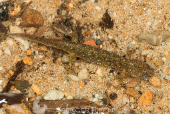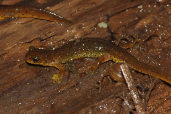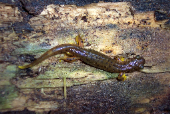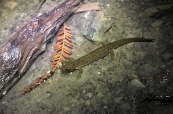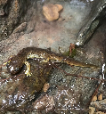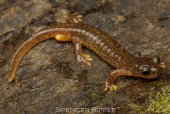Southern Torrent Salamander (Rhyacotriton variegatus)
Description: Adults are 1.5 - 2.4 inches long (4.0-6.2 cm) from snout to vent. A medium-sized salamander with a slim body, a short tail, and a small head with large protuberant eyes. Coloring is olive to brown dorsally with dark and light speckling. The ventral surface yellowish, similarly speckled. The eyes are large and dark, flecked with metallic gold. Males have distinct squareish cloacal lobes.
Habitat: Found in shallow, cold, clear, well-shaded streams, waterfalls and seepages, particularly those running through talus and under rocks all year, in mature to old-growth forests. Occasionally found in riparian vegation adjacent to water, but usually found in contact with water.
Found primarily in waters on north-facing slopes in the southern part of their range where forests are warmer and drier. Aquatic larvae live in clear shallow water and still, mucky water in creeks, often with accumulated leaves.
Range: In California, this species occurs throughout humid coastal drainages from near Pt. Arena in southern Mendocino Co., to the Oregon border in the coniferous belt. Outside of California occurs north in Oregon along the coast and inland into the Cascade Mountains. An isolated population occurs east of the established range in the upper McCloud River drainage in Siskiyou County.
Found in these States:
CA |
WA
Diet: Diet consists primarily of aquatic and semi-aquatic invertebrates, including amphipods, and springtails.
Reproduction: Reproduction is aquatic. Sexual maturity takes approximately 4-5 years. Breeding may occur throughout the year, but the peak oviposition period is in August and September. Eggs of this species are very difficult to find in the wild and there are few descriptions of them. Eggs may be laid throughout the year, with the peak oviposition period taking place in August and September. Approximately 4 to 16 non-pigmented eggs are laid in water singly (not in clusters) and attached underneath rocks in streams with gravel substrates. Egg development is slow, taking about 8 months for eggs to hatch. Peak egg hatching occurs in the spring.
Status: Listed as Vulnerable in Oregon and as Imeriled in California.
»» Kingdom: Animalia - Animals
»» Phylum: Chordata - Chordates
»» Subphylum: Vertebrata - Vertebrates
»» Class: Amphibia - (Amphibians)
»» Order: Caudata - Salamanders
»» Family: Rhyacotritonidae - Torrent Salamanders
»» Genus: Rhyacotriton
»» Species: Rhyacotriton variegatus - Southern Torrent Salamander
This article uses material from the Wikipedia article "Southern Torrent Salamander", which is released under the Creative Commons Attribution-Share-Alike License 3.0. Content may have been omitted from the original, but no content has been changed or extended.
|


